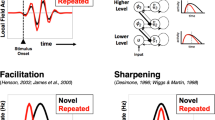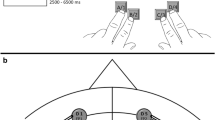Abstract
Recent observation of objects speeds up their subsequent identification and classification1,2. This common form of learning, known as repetition priming, can operate in the absence of explicit memory for earlier experiences3,4, and functional neuroimaging has shown that object classification improved in this way is accompanied by ‘neural priming’ (reduced neural activity) in prefrontal, fusiform and other cortical regions5,6,7,8,9,10. These observations have led to suggestions that cortical representations of items undergo ‘tuning’, whereby neurons encoding irrelevant information respond less as a given object is observed repeatedly10, thereby facilitating future availability of pertinent object knowledge. Here we provide experimental support for an alternative hypothesis, in which reduced cortical activity occurs because subjects rapidly learn their previous responses11. After a primed object classification (such as ‘bigger than a shoebox’), cue reversal (‘smaller than a shoebox’) greatly slowed performance and completely eliminated neural priming in fusiform cortex, which suggests that these cortical item representations were no more available for primed objects than they were for new objects. In contrast, prefrontal cortex activity tracked behavioural priming and predicted the degree to which cue reversal would slow down object classification—highlighting the role of the prefrontal cortex in executive control.
This is a preview of subscription content, access via your institution
Access options
Subscribe to this journal
Receive 51 print issues and online access
$199.00 per year
only $3.90 per issue
Buy this article
- Purchase on Springer Link
- Instant access to full article PDF
Prices may be subject to local taxes which are calculated during checkout



Similar content being viewed by others
References
Tulving, E. & Schacter, D. L. Priming and human memory systems. Science 247, 301–306 (1990)
Toth, J. P. & Reingold, E. M. in Implicit Cognition (ed. Underwood, G. D. M.) 41–84 (Oxford Univ. Press, London, 1996)
Squire, L. R. & McKee, R. Influence of prior events on cognitive judgments in amnesia. J. Exp. Psychol. 18, 106–115 (1992)
Schacter, D. L., Chiu, C. Y. P. & Ochsner, K. N. Implicit memory: A selective review. Annu. Rev. Neurosci. 16, 159–182 (1993)
Raichle, M. E. et al. Practice-related changes in human brain functional anatomy during nonmotor learning. Cereb. Cortex 4, 8–26 (1994)
Demb, J. B. et al. Semantic encoding and retrieval in the left inferior prefrontal cortex: a functional MRI study of task difficulty and process specificity. J. Neurosci. 15, 5870–5878 (1995)
Buckner, R. L. et al. Functional anatomical studies of explicit and implicit memory retrieval tasks. J. Neurosci. 15, 12–29 (1995)
Wagner, A. D., Desmond, J. E., Demb, J. B., Glover, G. H. & Gabrieli, J. D. E. Semantic repetition priming for verbal and pictorial knowledge: A functional MRI study of left inferior prefrontal cortex. J. Cogn. Neurosci. 9, 714–726 (1997)
Schacter, D. L. & Buckner, R. L. Priming and the brain. Neuron 20, 185–195 (1998)
Wiggs, C. L. & Martin, A. Properties and mechanisms of perceptual priming. Curr. Opin. Neurobiol. 8, 227–233 (1998)
Logan, G. D. Repetition priming and automaticity: Common underlying mechanisms? Cognit. Psychol. 22, 1–35 (1990)
Vriezen, E. R., Moscovitch, M. & Bellos, S. A. Priming effects in semantic classification tasks. J. Exp. Psychol. 21, 933–946 (1995)
Koutstaal, W. et al. Perceptual specificity in visual object priming: functional magnetic resonance imaging evidence for a laterality difference in fusiform cortex. Neuropsychologia 39, 184–199 (2001)
Thompson-Schill, S. L., D'Esposito, M. & Kan, I. P. Effects of repetition and competition on activity in left prefrontal cortex during word generation. Neuron 23, 513–522 (1999)
Kane, M. J. & Engle, R. W. The role of prefrontal cortex in working-memory capacity, executive attention, and general fluid intelligence: an individual-differences perspective. Psychonom. Bull. Rev. 9, 637–671 (2002)
Henson, R., Shallice, T. & Dolan, R. Neuroimaging evidence for dissociable forms of repetition priming. Science 287, 1269–1272 (2000)
Gauthier, I. & Nelson, C. A. The development of face expertise. Curr. Opin. Neurobiol. 11, 219–224 (2001)
Schacter, D. L. in Memory Systems of the Brain (eds Weinberger, N. M., McGaugh, J. L. & Lynch, G.) 351–379 (The Guilford Press, New York, 1985)
Hayman, C. G. & Tulving, E. Is priming in fragment completion based on a “traceless” memory system? J. Exp. Psychol. 15, 941–956 (1989)
Henson, R. N. Neuroimaging studies of priming. Prog. Neurobiol. 70, 53–81 (2003)
Squire, L. R. et al. Activation of the hippocampus in normal humans: a functional anatomical study of memory. Proc. Natl Acad. Sci. USA 89, 1837–1841 (1992)
Schacter, D. L. et al. Conscious recollection and the human hippocampal formation: evidence from positron emission tomography. Proc. Natl Acad. Sci. USA 93, 321–325 (1996)
Henson, R. N. et al. Electrophysiological and haemodynamic correlates of face perception, recognition and priming. Cereb. Cortex 13, 793–805 (2003)
Simons, J. S., Koutstaal, W., Prince, S., Wagner, A. & Schacter, D. Neural mechanisms of visual object priming: Evidence for perceptual and semantic distinctions in fusiform cortex. Neuroimage 19, 613–626 (2003)
Dale, A. M. Optimal experimental design for event-related fMRI. Hum. Brain Mapp. 8, 109–114 (1999)
Acknowledgements
We thank L. Nicholls for help with data collection and analysis. This research was supported by grants from the NIMH (D.L.S. and D.M.S.), NINDS (M.V.) and the NIA (D.L.S.).
Author information
Authors and Affiliations
Corresponding author
Ethics declarations
Competing interests
The authors declare that they have no competing financial interests.
Rights and permissions
About this article
Cite this article
Dobbins, I., Schnyer, D., Verfaellie, M. et al. Cortical activity reductions during repetition priming can result from rapid response learning. Nature 428, 316–319 (2004). https://doi.org/10.1038/nature02400
Received:
Accepted:
Published:
Issue Date:
DOI: https://doi.org/10.1038/nature02400
This article is cited by
-
Repetition Suppression for Familiar Visual Words Through Acceleration of Early Processing
Brain Topography (2023)
-
Enhanced inter-regional coupling of neural responses and repetition suppression provide separate contributions to long-term behavioral priming
Communications Biology (2021)
-
Illuminating the prefrontal neural correlates of action sequence disassembling in response–response binding
Scientific Reports (2021)
-
Execution-based and verbal code-based stimulus–response associations: proportion manipulations reveal conflict adaptation processes in item-specific priming
Psychological Research (2020)
-
Reward priming eliminates color-driven affect in perception
Psychological Research (2019)
Comments
By submitting a comment you agree to abide by our Terms and Community Guidelines. If you find something abusive or that does not comply with our terms or guidelines please flag it as inappropriate.



